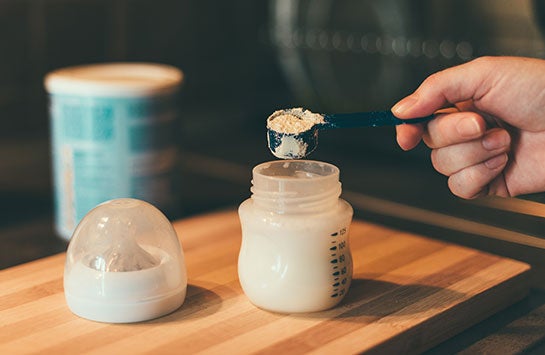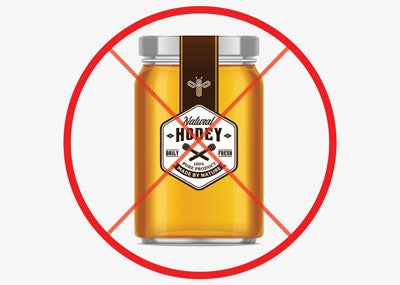Newborn Guide: Feeding
Newborn Guide: Additional Topics
Topic: Feedings

Feeding is one of your baby’s most pleasant experiences. At feeding time, your baby not only receives nourishment but also a feeling of security from your loving care. The food helps your baby grow healthy and strong. Loving care helps develop a secure and stable personality.
Both you and your baby should be comfortable at feeding time. Choose a position that will help you relax as you feed your baby. Be sure your baby is warm and dry.
The feeding schedule should be flexible, allowing your baby to eat when she/he becomes hungry. Very young babies usually want to eat every 1½ to 3 hours; some of them want to eat every 1½ hours at various times during the day. Although crying is the only way a young baby can complain of hunger, crying may mean other things as well. If your baby occasionally cries within one hour after a feeding, check for other causes such as an uncomfortable position or a wet diaper.
There are basically three ways to feed babies: breastfeeding, formula, or a combination of the two. Breastfeeding offers medical advantages, but any of these ways is acceptable and provides good nutrition and nurturing.
Breastfeeding
Attitude is very important in breastfeeding, so be relaxed and confident and you are sure to be successful. Breast milk, by all standards, appears to be the perfect food for a newborn. At first, there is no milk in your breasts, but your baby will still get colostrum which provides natural intestinal immunity and helps start stools, ridding your baby of the sticky meconium. Find a comfortable position for you and your baby. Good positioning is key to good feedings.
During these first few days of nursing, if your nipples are sore or tender, limit your baby to five minutes per breast and increase the time by about one minute per day. Let your baby nurse from both breasts each time. With time, the period may be extended but periods in excess of twenty minutes are rarely necessary for the baby to eat all he/she needs. Our lactation specialist can provide education and assistance with latching and any other breastfeeding concerns.
If your nipples do crack and get sore, the following will help them heal.
- Permit them to air-dry after nursing, letting a little breast milk dry on the nipple.
- Avoid soap on your nipples when bathing. This removes the natural protective oils.
- Apply “Masse” breast cream after nursing.
- Apply cold compresses to the tender nipples after nursing.
Once your milk is in, (about the third day) and your milk supply well established, your baby should nurse 8-12 times a day and have at least 6 wet diapers a day. Loose, seedy stools are normal for breastfed babies.
If you need to be separated from your baby at feeding time, you can leave behind a bottle of milk that you have pumped from your breasts, or you can leave a bottle of formula. Pumping your breasts and freezing the breast milk for later use works quite well.
If you decide to stop breastfeeding before 1 year of age, you should use formula as outlined in the following section.
Cow’s milk in not a suitable substitute before your baby is 1 year old.
Formula feeding

Formula Feeding
If you are formula feeding or supplementing your breastfeeding with formula, the following suggestions may be of value. Cow’s milk is not an appropriate feeding for a newborn and should be avoided until an infant is 12 months of age. Although cow’s milk is fortified with vitamin D, it lacks vitamins A and C, and iron that baby needs to grow and develop normally. We advise that you use infant formula with iron for the first year of life. These formulas come in varying preparations: powdered, liquid concentrate, and ready to feed. Once opened, formula should not be kept for more than 48 hours.
Feedings
column
Important Formula Points
Please read and follow the directions for mixing carefully. For most cases, if your water is city water, it is safe to use as is. Any type of bottle may be used. It is important the holes are large enough that if the bottle is turned upside down the milk should drip from the holes without having to press on it. If the holes are too small, enlarge them with a hot needlepoint.
Bottle Washing
It is of utmost importance that bottles, nipples and items used in preparation of formula be kept healthfully clean. Washing with hot soapy water, using a bottle brush, squeezing the soapy water through the nipple holes, and then rinsing everything well with hot water is the best way to protect your baby from unwanted germs. You may also use a dishwasher or bottle streamer. If you have an approved water supply, there is no need to sterilize bottles.
Solids
According to the Committee on Nutrition of the American Academy of Pediatrics, there is no need to begin to feed a baby solid foods before 4-6 months of age. When that time is near, we will discuss the addition of new foods with you. Baby food should always be fed with a spoon.
column
Temperature
Formula may be offered at room temperature or slightly warmer. Test the temperature of the formula before giving it to your baby. Microwaving the formula may make it too warm too quickly. If you do use a microwave, be sure to shake the bottle to mix it before testing the temperature. If the temperature of the formula is too warm when dripped onto your inner wrist, it is too warm for your baby.
Burping
Encouraging your baby to burp is essential. Be patient. Some babies are better at it than others. Changing your baby’s position often brings up the bubble. Attempt a burp in the middle and at the end of a feeding.
How Much to Feed
Start with 2-4 ounces of formula in each bottle, and increase it as your baby desires more. When the baby is consistently emptying a four-ounce bottle, offer more. 8 ounces is usually the maximum given at any one feeding. Once a can of formula is opened or mixed, please keep all unused formula in the refrigerator.
Honey notice

Do not give your baby honey before his/her first birthday.
Certain bacterial spores that are sometimes found in honey can cause a serious disease called infant botulism.
More
column
Vitamins
Mom should continue to take her prenatal vitamins. Supplemental vitamins for your baby are not needed unless your baby is solely breastfed. Vitamin D3 comes in a bottle with a dropper. You can squirt 400 IU (international units) into your baby’s mouth once each day.
column
Fluoride
From 6 months to 8 years of age, your baby will need supplemental fluoride to help his/her permanent teeth form. This fluoride can be obtained in water treated with fluoride (city water), by purchasing bottled water with fluoride added (nursery water), or by prescription (drops or pills). This will be discussed at your baby’s 6-month visit.
General Feeding Problems
General Feeding Problems
The following comments relate to feeding in general:
- Don’t force feedings
- Offer appropriate amounts at appropriate times, and be confident that your baby will eat what he/she needs. This will vary from feeding to feeding and day-to-day.
- All babies spit up at times. It is not abnormal as long as he/she continues to gain weight and grow.
- Please call us if your baby is vomiting green (bile) or blood, acting ill, or has a fever (100.4 rectally or 99.4 under the arm).
When to Call University Pediatrics (Click to Expand)
When to Call University Pediatrics (Click to Expand)
Call us any time of the day or night if your baby has any of the following:
- Rectal temp of 100.4º or greater in a baby 2 months of age or less
- Unusually inactive or quiet
- Excessive crying for no reason
- Vomiting bile or blood
- Repeated vomiting (not just spitting up)
- Breathing hard (using abdominal muscles to breathe)
- Dusky or bluish coloring
If you are experiencing an emergency, you can call us any time of the day or night. If the office is closed, your call will be answered by a nurse who can answer most of your questions and suggest what to do. The nurse can always reach one of our physicians if needed. Our office is open Mon-Fri, 8:30am-5:00pm.
24/7 Phone: (309) 624-9680
Contact University Pediatrics

Next in Our Newborn Guide
Topic: Sleep and General Safety
Advice on sleeping positions, cribs, car safety, and more…